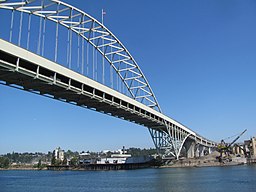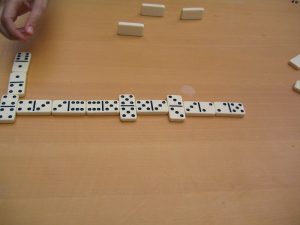A Word of Caution
Signal words and phrases can be helpful to signal a shift in ideas within a paragraph. But it’s also important to understand that these types of transitions shouldn’t be too frequent within a paragraph. Here are some examples to help you see the difference between transitions that feel like they occur naturally and transitions that seem forced and make the paragraph awkward to read:
Too Many Transitions (Awkward): The Impressionist painters of the late 19th century are well known for their visible brush strokes, for their ability to convey a realistic sense of light, and for their everyday subjects portrayed in outdoor settings. In spite of this fact, many casual admirers of their work are unaware of the scientific innovations that made it possible this movement in art to take place. Then, In 1841, an American painter named John Rand invented the collapsible paint tube. To illustrate the importance of this invention, pigments previously had to be ground and mixed in a fairly complex process that made it difficult for artists to travel with them. For example, the mixtures were commonly stored in pieces of pig bladder to keep the paint from drying out. In addition, when working with their palettes, painters had to puncture the bladder, squeeze out some paint, and then mend the bladder again to keep the rest of the paint mixture from drying out. Thus, Rand’s collapsible tube freed the painters from these cumbersome and messy processes, allowing artists to be more mobile and to paint in the open air.
Subtle Transitions that Aid Readers’ Understanding (More Natural): The Impressionist painters of the late 19th century are well known for their visible brush strokes, for their ability to convey a realistic sense of light, and for their everyday subjects portrayed in outdoor settings. However, many casual admirers of their work are unaware of the scientific innovations that made it possible for this movement in art to take place. In 1841, an American painter named John Rand invented the collapsible paint tube. Before this invention, pigments had to be ground and mixed in a fairly complex process that made it difficult for artists to travel with them. The mixtures were commonly stored in pieces of pig bladder to keep the paint from drying out. When working with their palettes, painters had to puncture the bladder, squeeze out some paint, and then mend the bladder again to keep the rest of the paint mixture from drying out. Rand’s collapsible tube freed the painters from these cumbersome and messy processes, allowing artists to be more mobile and to paint in the open air.
Transitions between Paragraphs and Sections
It’s important to consider how to emphasize the relationships not just between sentences but also between paragraphs in your essay. Here are a few strategies to help you show your readers how the main ideas of your paragraphs relate to each other and also to your thesis.
Use Signposts
Signposts are signal words or phrases that indicate where you are in the process of organizing an idea; for example, signposts might indicate that you are introducing a new concept, that you are summarizing an idea, or that you are concluding your thoughts. Some of the most common signposts include words and phrases like first, then, next, finally, in sum, and in conclusion. Be careful not to overuse these types of transitions in your writing. Your readers will quickly find them boring, repetitive, or too obvious. Instead, think of more creative ways to let your readers know where they are situated within the ideas presented in your essay. You might say, “The first problem with this practice is…” Or you might say, “The next thing to consider is…” Or you might say, “A final point to take into account is….”
Use Forward-Looking Sentences at the End of Paragraphs
Sometimes, as you conclude a paragraph, you might want to give your readers a hint about what’s coming next. For example, imagine that you’re writing an essay about the benefits of trees to the environment and you’ve just wrapped up a paragraph about how trees absorb pollutants and provide oxygen. You might conclude with a forward-looking sentence like this: “Trees benefits to local air quality are important, but surely they have more to offer our communities than clean air.” This might conclude a paragraph (or series of paragraphs) and then prepare your readers for additional paragraphs to come that cover the topics of trees’ shade value and ability to slow water evaporation on hot summer days. This transitional strategy can be tricky to employ smoothly. Make sure that the conclusion of your paragraph doesn’t sound like you’re leaving your readers hanging with the introduction of a completely new or unrelated topic.
Use Backward-Looking Sentences at the Beginning of Paragraphs
Rather than concluding a paragraph by looking forward, you might instead begin a paragraph by looking back. Continuing with the example above of an essay about the value of trees, let’s think about how we might begin a new paragraph or section by first taking a moment to look back. Maybe you just concluded a paragraph on the topic of trees’ ability to decrease soil erosion and you’re getting ready to talk about how they provide habitats for urban wildlife. Beginning the opening of a new paragraph or section of the essay with a backward-looking transition might look something like this: “While their benefits to soil and water conservation are great, the value that trees provide to our urban wildlife also cannot be overlooked.”
Evaluate Your Transitions
As you revise your draft, make sure you include transitions where you need them, and omit them where they are unnecessary. Try reading your draft aloud. Listen for areas that sound choppy or abrupt. This can help you make note of areas where transitions need to be added. Repetition is another problem that can be easier to find if you read your essay aloud. If you notice yourself using the same transitions over and over again, take time to find some alternatives.
Choose an essay or piece of writing, either that you’re currently working on, or that you’ve written in the past. Identify your major topics or main ideas. Then, using the suggestions in this chapter, develop at least three examples of sentence-level transitions and at least two examples of paragraph-level transitions.
Share and discuss with your classmates in small groups, and choose one example of each type from your group to share with the whole class. If you like the results, you might use them to revise your writing. If not, try some other strategies.



